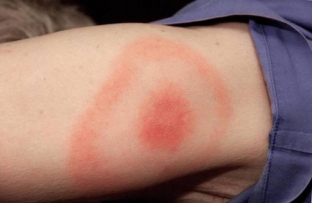Lyme disease, for which there is currently no vaccine, is the most common natural focal vector-borne infectious disease in Europe, Asia and North America. Eurasia is the largest natural distribution area for this disease, emphasizes estet-portal.com. The disease is transmitted by ixodid ticks and, according to annual statistics, the incidence of Lyme disease has risen 25 times since 1982. What are the symptoms and treatment of Lyme disease?
How do people get Lyme disease?
Lyme disease, sometimes referred to as the "invisible" disease, is diagnosed by symptoms that include the most characteristic feature of the disease, erythema migrans annulare, the disease's pathognomonic skin rash.
This disease often has symptoms of many other diseases, from arthritis to chronic fatigue syndrome.
The patients appear healthy and do not report the fact of being bitten by the tick that is responsible for this disease. They do not have antibodies to this pathogen - and yet, we are talking about borrelliasis, an infectious disease arising from tick bites.
Because many Lyme patients do not mention the fact of being bitten by a tick, some experts believe that Borrelia can be transmitted by other insects:
- mosquitoes,
- spiders,
- fleas,
- scabies mites.
Is Lyme disease transmitted?
The Centers for Disease Control and Prevention refutes this opinion, in addition, at the moment there are no reliable data on the possibility of transmission of Lyme disease from person to person when:
- handshake,
- kiss,
- sexual contact with the patient.
There is no unequivocal opinion regarding vertical transmission (from mother to fetus). Lyme disease acquired during pregnancy can lead to transplacental infection and possible fetal death or stillbirth. However, there were no cases of a negative impact of an infectious disease on the fetus if pregnant women followed the prescribed antibiotic therapy.
Despite the existence of Lyme disease in dogs and cats, there is no evidence of direct infection of hosts from their pets.
Most often, the diagnosis of Lyme disease is based on pathognomonic symptoms, so treatment is based on information about possible contact with ticks.
Lyme Disease Symptoms and Diagnosis
As with other infectious diseases, serodiagnosis in Lyme disease in the first weeks of the disease is expected to give negative results. A few weeks after infection, enzyme-linked immunosorbent assay (ELISA) may detect antibodies to B. burgdorferi. In the case of a positive ELISA result, a Western blot test is used to confirm the diagnosis. The specificity and reliability of these laboratory tests depend on the stage of the disease.
Small hyperemic papules usually appear at the site of a tick bite. These papules are a normal reaction to a tick bite and not a specific symptom of Lyme disease. However, over the following days, the area of hyperemia may increase with the formation of a skin rash pathognomonic for Lyme disease in the form of annular erythema migrans - with an outer bright red ring surrounding an area of skin of an unchanged color. The rash looks like a target.

However, in many patients, the nature of the skin rash is not pronounced pathognomonic in nature; in some patients, elements of the rash occur in several areas of the skin. Flu-like symptoms such as:
- fever,
- chills,
- lethargy,
- feeling of ache all over the body,
- headache,
may accompany skin symptoms.
Read also: Tick-borne dermatoses and other summer hazards
Complications of Lyme disease
If left untreated, the infection spreads to the joints, heart muscle, and nervous system. At this stage, the symptoms of the disease include severe joint pain and swelling, emphasizes estet-portal.com. The knee joints are the most vulnerable, although the pain may migrate. Within weeks, months, or even years of infection, patients may develop:
- meningitis,
- temporary paralysis of one half of the face (Bell's palsy),
- weakness in limbs,
- Various motor dysfunctions.
A few weeks after the illness, a number of patients develop less typical symptoms, such as:
- cardiac disorders - arrhythmias, usually lasting no more than a few days or weeks;
- conjunctivitis or episcleritis;
- hepatitis;
- expressed weakness.
Clinical Mimicry of Lyme Disease
Migrating annular erythema, pathognomonic for Lyme disease, is absent in more than half of patients, and less than half of patients report the fact of a tick bite. According to some reports, this proportion of patients may not exceed 15%.
Specialists consider Lyme disease to be the “great mimic” because it mimics other diseases such as:
- multiple sclerosis,
- autoimmune and reactive arthritis,
- chronic fatigue syndrome,
- fibromyalgia,
- Alzheimer's disease.
At the same time, many patients look quite healthy, they do not detect antibodies to the causative agent of the disease during serodiagnosis. This is why Lyme disease is often referred to as the “invisible” disease.
Treatment of Lyme disease in relation to symptoms
Early use of antibiotic therapy, as a rule, led to a quick and complete recovery of patients. However, most patients in the late stages of the disease also respond well to ongoing antibiotic therapy, although they may retain symptoms of the nervous system and joints for a long time.
In 10–20% of patients, symptoms such as:
- weakness,
- muscle pain,
- Insomnia,
- mental disorders,
even after completing a full course of antibiotic treatment. With these symptoms, patients are not subject to long-term treatment with antibacterial drugs, but over time they notice an improvement in the condition without additional therapy.
Doxycycline is recommended for adults and children over 8 years of age, amoxicillin or cefuroxime for younger children, pregnant women, and women who are breastfeeding.
Parenteral administration of antibiotics is recommended when the central nervous system is involved in the infectious process. This therapy is an effective method of eliminating the infectious agent from the body, although it may take some time to completely eliminate the symptoms of the disease, according to estet-portal.com.






Add a comment